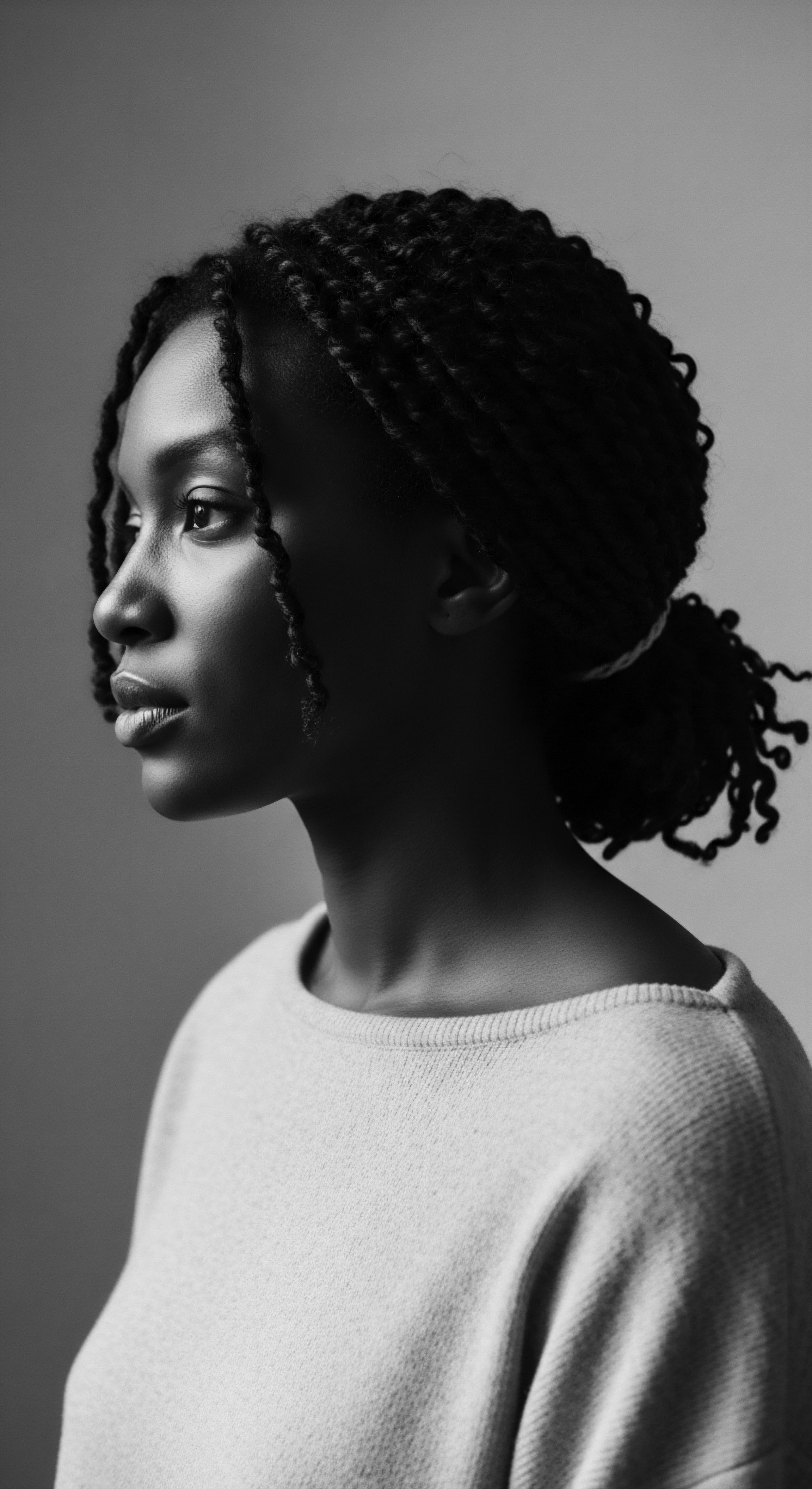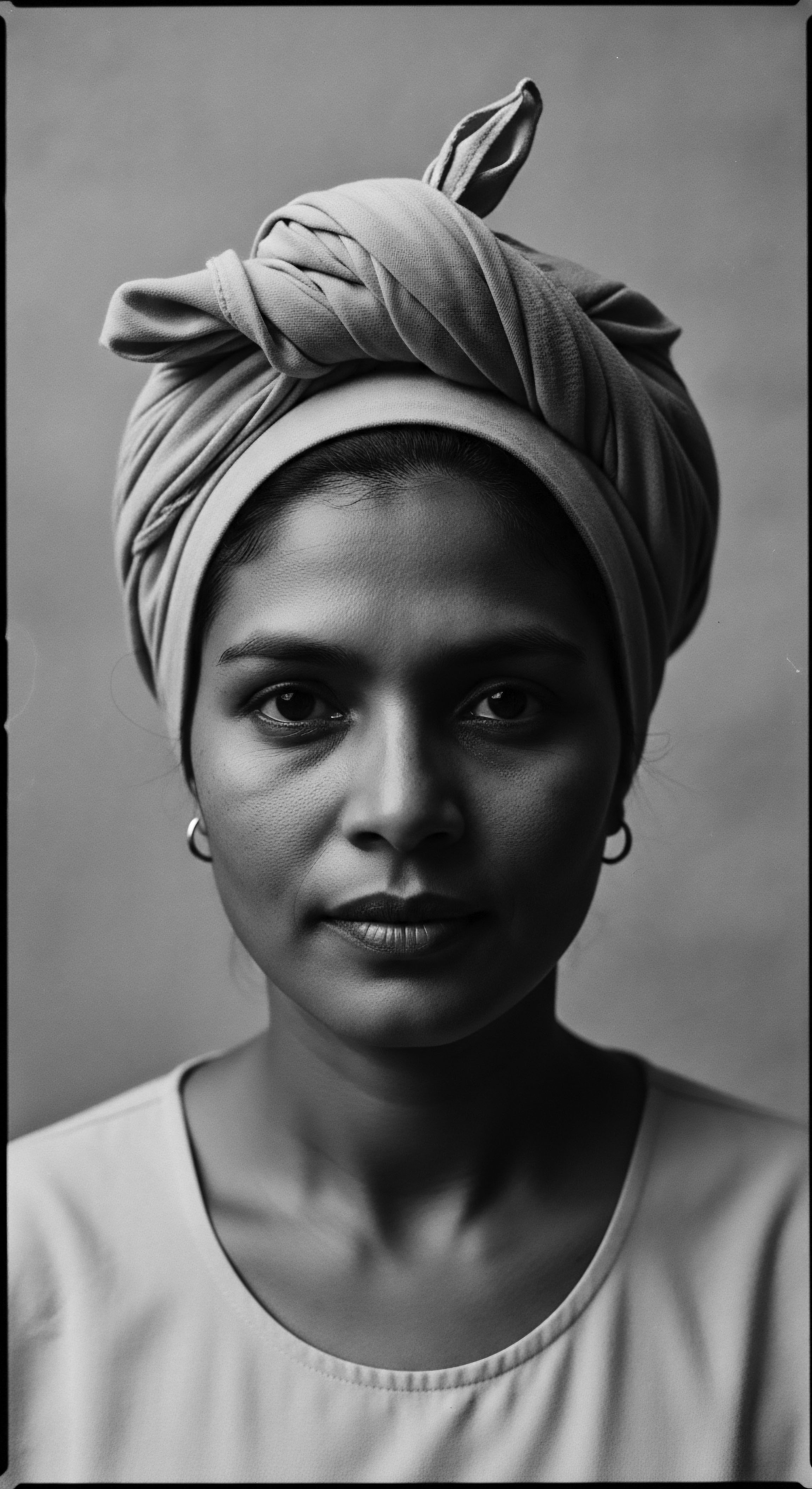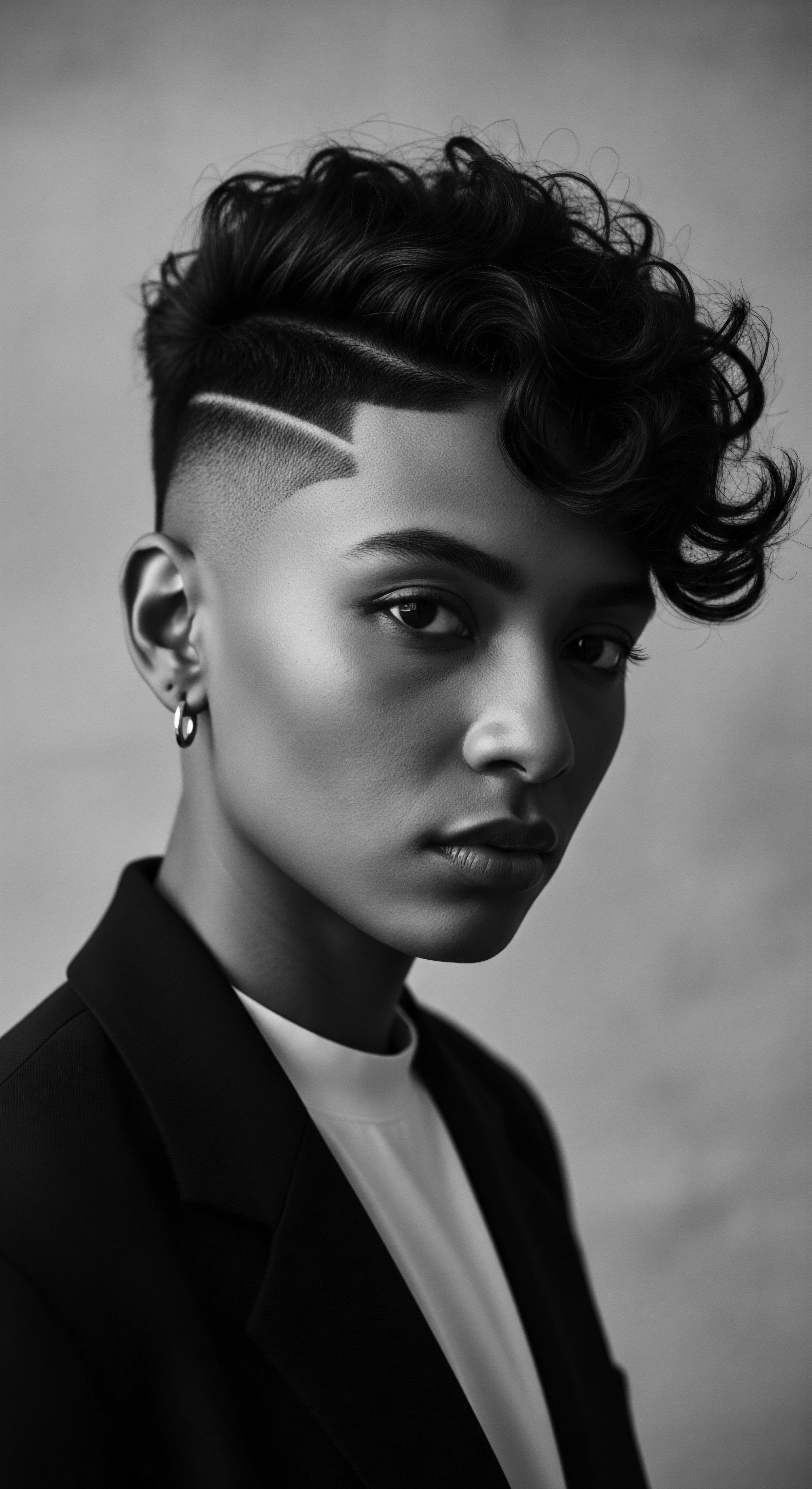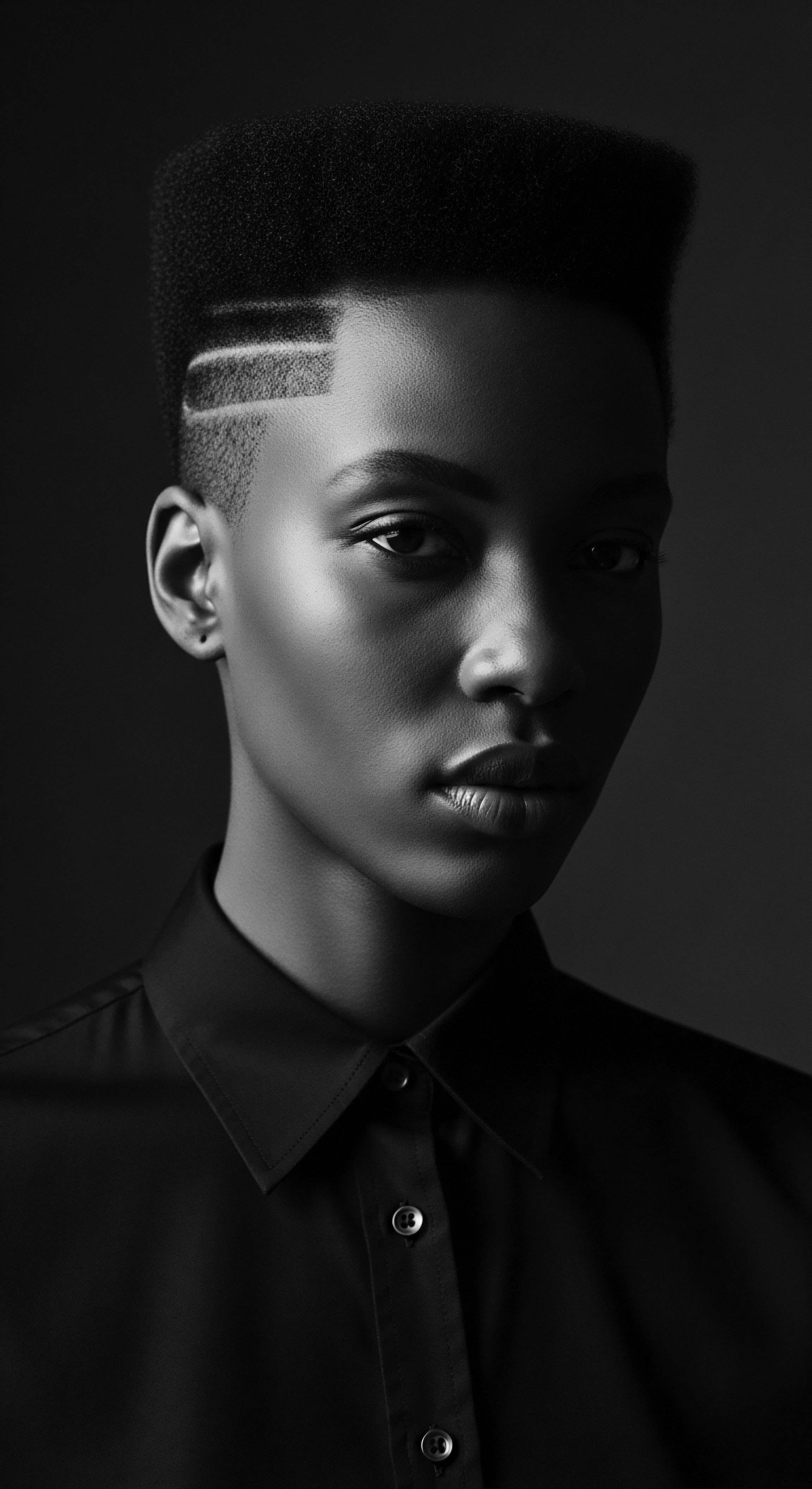
Roots
Consider a single strand of textured hair, not just as a biological structure, but as a living archive. It holds whispers of ancient hands, secrets of verdant landscapes, and the echoes of generations. For too long, the wisdom held within these very strands, and the profound traditions of their care, were overlooked or actively suppressed. Yet, as we stand at this precipice of discovery, the question arises with a certain resonance ❉ Can ancestral plant wisdom truly inform modern textured hair care?
It’s a journey from the very core of our being, a reconnection to practices that understood hair not as a mere adornment, but as a sacred extension of self and community, a keeper of heritage. This inquiry is an invitation to explore the deep cultural knowledge that precedes our contemporary understanding, to see how the botanicals of old offer insights for the textures we cherish today.

Hair Anatomy and Its Historical Lens
The unique architecture of textured hair, with its characteristic coils and curves, sets it apart. This intricate helical structure dictates how natural oils descend the strand, how moisture is retained or lost, and how it responds to its environment. Modern hair science dissects the cuticle, cortex, and medulla, revealing the microscopic symphony at play within each coil. Yet, long before electron microscopes, ancestral communities possessed an intuitive grasp of these very properties.
Their methods, honed over centuries, compensated for hair’s natural inclination toward dryness, its tendency to resist certain forms of manipulation, and its inherent strength when properly tended. They observed the hair’s reactions to sun, wind, and water, learning to protect and nourish it with what their immediate world provided.
This historical understanding is crucial. European explorers, for instance, often pathologized tightly coiled hair, fabricating scientific data to assert racial domination and justify the ‘civilization’ of Africans. This distorted narrative, unfortunately, permeated later scientific classifications and beauty standards, creating a legacy of misunderstanding.
A crucial shift involves recognizing the natural characteristics of textured hair as an aspect of its beauty, rather than a deviation from a perceived norm. The tightness of coils, ranging from loose waves to tight coils, influences how natural oils produced by the scalp travel down the hair shaft, making moisture retention a constant focus in textured hair care.
Understanding the intricate structure of textured hair is not just scientific curiosity; it is a vital step in honoring its ancestral resilience.

Ancient Lexicon of Hair and Plant Use
Across continents, a rich lexicon exists for textured hair, often interwoven with terms for its care and adornment. These words are not simple labels; they carry the weight of tradition, communal practices, and an ecological literacy that recognized the healing properties of plants. We see this in the various ways different African and Indigenous American cultures named and understood hair types, styling techniques, and the botanical ingredients used for their maintenance. For example, in pre-colonial Africa, hairstyles communicated geographical origin, marital status, age, ethnic identity, religion, wealth, and social rank.
- Chebe ❉ A powder made from specific plants native to Chad, particularly the Croton zambesicus, traditionally used by Basara Arab women to coat and protect natural hair, preventing breakage and aiding length retention.
- Yucca ❉ A root used by various Native American tribes to create a natural shampoo, producing a soapy lather for cleansing and nourishing hair.
- Saponins ❉ Natural compounds found in numerous African plants, such as soapberry, which produce a lather when agitated in water and were traditionally used for washing and hair cleansing, possessing antimicrobial properties.

Hair Growth Cycles ❉ Ancestral Observations
Ancestral communities, without the benefit of modern microscopy, observed the cycles of hair growth with remarkable accuracy. They understood that hair underwent periods of growth, rest, and shedding. Their practices often aligned with these cycles, promoting scalp health to ensure healthy growth. This meant using ingredients that stimulated the scalp, protected existing strands, and minimized factors that could lead to premature shedding.
Consider the use of Moringa Oil, revered across various cultures including Jamaican traditions, which is rich in vitamins and antioxidants, known to strengthen hair, reduce split ends, and promote a healthy scalp. It supports healthy cell and tissue growth, fighting hair loss by boosting circulation and providing essential nutrients.
| Ancestral Plant Cleanser Yucca Root |
| Traditional Use in Heritage Native American tribes crushed this root, mixing it with water for a natural, sudsing shampoo, leaving hair clean and nourished. |
| Modern Scientific Insight Contains saponins, natural surfactants that create lather and possess cleansing properties, effectively removing dirt and impurities. |
| Ancestral Plant Cleanser African Soap Plants |
| Traditional Use in Heritage Various communities in Southern Africa rubbed leaves, roots, or fruits of plants like soapberry in water to create lather for washing hair. |
| Modern Scientific Insight These plants are rich in saponins, which are natural detergents and have documented antiviral, antibacterial, and antifungal activities, contributing to scalp hygiene. |
| Ancestral Plant Cleanser The persistent efficacy of these plant-based cleansers, passed down through generations, highlights the enduring value of ancestral botanical knowledge. |

Ritual
The acts of styling and caring for textured hair are rarely simple tasks; they are, more accurately, rituals. These practices, steeped in communal bonds and ancestral memory, transcend mere aesthetics. They are expressions of identity, resilience, and a profound connection to heritage.
The artistry involved, the tools employed, and the transformations achieved through care have always carried a deeper resonance, often informed by plant wisdom passed down through the ages. We can truly ask ❉ Does the wisdom of ancestral plant practices resonate with how we shape and transform textured hair today?

Protective Styling Ancestry
Protective styles—such as braids, twists, and locs—are more than just contemporary trends; they are direct descendants of ancient African traditions. Their origins trace back thousands of years, serving as profound visual languages. Specific patterns communicated social status, marital status, wealth, kinship, religious beliefs, and tribal affiliation. During the transatlantic slave trade, the forced shaving of hair was a deliberate act of dehumanization, a cruel attempt to strip enslaved Africans of their identity and cultural roots.
Yet, even in the darkest hours, hair became an act of defiance. Enslaved people braided patterns resembling escape maps into their hair and concealed grains like rice and beans within their strands to sustain themselves during flight. This serves as a powerful instance of resilience.
The practice of protective styling, therefore, is rooted in survival and cultural preservation. The science behind these styles—minimizing manipulation, protecting hair from environmental exposure, and reducing breakage—was understood intuitively by ancestral practitioners. Modern science confirms that these styles help retain length and promote hair health by shielding delicate strands.
Protective styles are living histories, each braid and twist a testament to ancestral ingenuity and enduring spirit.

Natural Styling and Defining Hair
Beyond protective styles, ancestral practices for natural styling and definition focused on enhancing the hair’s inherent beauty. Plants played a central part in achieving desired textures, shine, and manageability. Aloe vera, for example, widely used across Latin America and the Caribbean, serves as a natural conditioner, promoting growth and soothing scalp inflammation. Its hydrating properties leave hair feeling soft and silky.
The use of plant-based oils and butters was a foundational aspect of this care. Shea Butter, deeply cherished in many African communities, is a powerful moisturizer, preventing dryness and protecting hair from harsh environmental conditions. Similarly, Jamaican Black Castor Oil (JBCO), traditionally made by roasting castor beans and adding their ash to the oil, is known for its viscous nature which creates a protective layer on hair, sealing in moisture. While its ability to regrow hair is not definitively proven by modern science, its traditional role in moisture retention for natural hair is widely recognized.

Hair Adornment and Its Legacy
The tools and adornments used in ancient hair styling were extensions of the plants and materials available. Beads, cowrie shells, and plant fibers were not merely decorative; they held symbolic weight, denoting status, occasion, or spiritual connection. The Fulani people of West Africa, for instance, are known for their elaborate hairstyles adorned with beads and cowrie shells, symbolizing wealth and prosperity.
This practice speaks to a holistic view of beauty, where the materials from the earth were integrated into personal expression. These practices show how communities relied on locally available resources to maintain and beautify their hair.
| Plant Ingredient Hibiscus (leaves, flowers) |
| Traditional Styling or Care Application Used in India (Ayurvedic medicine) and Africa for stimulating hair growth, combating dandruff, and enhancing shine and volume. |
| Contemporary Relevance for Textured Hair Recognized for high vitamin C content, amino acids, and antioxidants, supporting collagen production, strengthening follicles, and protecting against premature greying. |
| Plant Ingredient Moringa (oil, leaves) |
| Traditional Styling or Care Application In various African and Caribbean traditions, used as a conditioner to strengthen hair, reduce split ends, and promote a healthy scalp. |
| Contemporary Relevance for Textured Hair Provides vitamins, minerals, and antioxidants (Vitamins A, B, C, E, iron, zinc), supporting scalp health, blood circulation, and strengthening hair follicles to prevent breakage. |
| Plant Ingredient Aloe Vera (gel) |
| Traditional Styling or Care Application Ancient civilizations in Latin America, African tribes, and Jamaican traditions used it as a natural conditioner, for promoting hair growth, and soothing scalp inflammation. |
| Contemporary Relevance for Textured Hair Known for its moisturizing properties, enzymes, vitamins, and minerals that hydrate, soothe, and protect the scalp and hair, aiding in overall hair health. |
| Plant Ingredient The enduring utility of these botanicals highlights a continuity of care from ancient times to modern textured hair routines. |

Relay
The lineage of textured hair care, from ancient practices to contemporary routines, is a living, breathing testament to cultural continuity and scientific validation. The question of whether ancestral plant wisdom truly informs modern textured hair care finds its fullest answer not in simple affirmation, but in a profound interconnectedness where past ingenuity meets present understanding. This connection is not merely anecdotal; it is increasingly supported by scientific inquiry that often validates the empirical observations of our forebears.

Building Personalized Regimens Rooted in Ancestry
Modern hair care often stresses the importance of personalized regimens, acknowledging that textured hair is far from monolithic. This tailored approach, in fact, echoes ancestral wisdom. Communities understood that the plants available locally, combined with individual hair needs and environmental conditions, dictated the most effective care.
They developed intricate systems of observation and adaptation. For example, the Basara Arab women of Chad developed the Chebe ritual specifically suited to their climate, using plants to prevent dryness and breakage in a harsh environment.
Scientific understanding of how various plant compounds interact with hair proteins, lipids, and scalp microbiota now provides a deeper rationale for these time-honored practices. The saponins in plants like yucca or African soap plants, which create a cleansing lather, have been scientifically confirmed to possess antimicrobial properties. This dual action of cleansing and protecting the scalp was intuitively understood and utilized for generations.
Consider the shift towards using natural, plant-based ingredients in modern products. This move aligns with ancestral practices and often addresses the limitations of synthetic alternatives. Products marketed to Black women, for instance, have historically contained potentially harmful ingredients, including hormone-disrupting parabens and ingredients linked to skin cancer. The return to botanical sources represents a rejection of these harmful legacies and a return to healthier, more sustainable methods.

The Nighttime Sanctuary and Bonnet Wisdom
The nighttime ritual for textured hair is a cornerstone of modern care, particularly the use of satin or silk bonnets and scarves. This practice, often seen as contemporary, has deeper historical roots. While the specific materials might have changed, the concept of protecting hair during sleep to prevent tangling, breakage, and moisture loss is an ancestral one.
Enslaved people, for example, often used scarves or kerchiefs to cover their hair, in part due to a lack of access to traditional tools and oils, but also likely for protection. This practice adapted and endured, becoming a symbol of self-care and preservation within the African diaspora.
The science behind bonnets is straightforward ❉ they reduce friction against absorbent pillowcases, thereby preserving moisture and preventing mechanical damage to the delicate hair shaft. This preventative care extends the life of styles and supports healthy growth. The connection to ancestral wisdom lies in the recognition of a simple, yet profoundly protective, habit passed down through generations, adapted to modern materials but maintaining its core purpose.

Problem Solving ❉ Ancestral Remedies and Modern Insights
Ancestral plant wisdom offers potent solutions for common textured hair concerns. Hair loss, scalp irritation, and breakage are not new problems.
- Hair Loss ❉ Ancient remedies frequently targeted hair loss. Hibiscus, used in Ayurvedic medicine for centuries, stimulates hair follicles and promotes keratin production, a protein vital for hair strength. Modern research confirms its richness in flavonoids and amino acids which boost scalp circulation, thereby supporting healthier hair growth.
- Scalp Health ❉ Many traditional practices centered on maintaining a healthy scalp as the foundation for healthy hair. Neem, a plant recognized in Jamaican traditions, improves blood circulation to the hair roots and possesses antibacterial, antifungal, and anti-inflammatory properties, creating a suitable environment for scalp health and growth. This validates its use in treating issues like dandruff and scalp irritation.
- Dryness and Breakage ❉ The application of oils and butters, as seen with Chebe powder and shea butter, directly addresses the issue of dryness and subsequent breakage. Chebe works by coating the hair strands, helping them retain moisture and protecting them from dry environments, allowing hair to grow to significant lengths without breaking off. This ancestral method directly counters the inherent tendency of textured hair to dry out quickly due to its coiled structure.
The dialogue between ancestral knowledge and modern science is a two-way street. Modern scientific tools can isolate active compounds, measure their efficacy, and explain the mechanisms of action, yet it is ancestral wisdom that often points us to the most effective natural remedies, showing us what works through centuries of empirical evidence. This confluence allows for the creation of informed, effective, and respectful textured hair care that truly honors its heritage.
The profound efficacy of ancestral botanical remedies for hair health is being increasingly affirmed by contemporary scientific findings.

Reflection
To stand at the precipice of textured hair care in our current moment is to acknowledge a lineage, a living archive of wisdom etched into every strand. The query, “Can ancestral plant wisdom truly inform modern textured hair care?” finds its resounding affirmation not in a simple yes, but in a profound rediscovery. It is a journey back to the soil, to the forests, to the hands that first coaxed nourishment from the earth, and to the communities that guarded this knowledge with reverence. The solutions we seek for thriving textured hair today were often whispered in ancient languages, gathered from botanicals under different suns, and passed down through generations whose very existence was intertwined with the health and symbolism of their crowns.
The essence of Roothea’s ‘Soul of a Strand’ ethos is precisely this ❉ recognizing that textured hair carries not just genetic code, but also cultural narrative, historical resilience, and ancestral memory. The plants used centuries ago—Chebe, Yucca, Moringa, Hibiscus, Shea, and countless others—were not mere ingredients. They were partners in care, instruments of identity, and symbols of a deep connection to the natural world. Their continued relevance is a testament to an enduring truth ❉ the earth holds remedies, and our forebears knew how to find them.
By consciously seeking out and understanding these ancient botanical practices, we do more than just care for our hair; we participate in a powerful act of remembrance, honoring the ingenuity and spirit of those who came before us. This is the living legacy of textured hair heritage, an ongoing conversation between the past and the present, ensuring that every coil and curve tells a story of survival, beauty, and wisdom.

References
- De Solis, H. (1603). Tipus orbis terrarum. Library of Congress.
- Buel, J. W. (1890). Tipo Tib’s fresh captives being sent into bondage – witnessed by Stanley. Library of Congress.
- Sloan, J. (1975). Wig shop, Nashville. Library of Congress.
- Madam C.J. Walker—Preparations. (1920). Library of Congress.
- Omotos, L. The Dreaded Colonial Legacy ❉ African Hairstyles. The Gale Review.
- Gordon, M. (n.d.). Hair ❉ A Cultural History.
- Tharps, L. (2021). Tangled Roots ❉ Decoding the History of Black Hair. CBC Radio.
- Allen, M. (2021). Braids, Plaits, Locs ❉ The History of Black Protective Hairstyles. Royaltee Magazine.
- Adeyemo, Y. (2020). Examining the history and value of African hair. NativeMag.
- Bates, G. (2020). On Liberating the History of Black Hair. Literary Hub.
- Gholizadeh, M. (2022). Afro-Ethnic Hairstyling Trends, Risks, and Recommendations. MDPI.
- Dixon, C. & Jackson, J. (2023). What Every Dermatologist Must Know About the History of Black Hair.
- Oyateru, J. (2024). How African Beauty Brands Are Merging Science and Local Ingredients. BeautyMatter.
- Mensah, C. (2024). How African Beauty Brands Are Merging Science and Local Ingredients. BeautyMatter.
- A Crowning Glory ❉ Hair as History, Identity, and Ritual. (2024). Khumbula.
- The Power of Hair in African Folklore ❉ Rituals and Traditions. (2024). Bebrų Kosmetika.
- The Ancient Natural Ways of Hair Care Across Continents. (n.d.). 22 Ayur.
- 5 Herbs Used by Native Americans for Hair Care. (n.d.). T’zikal Beauty.
- Native American Hair Growth Secrets ❉ 5 Hair Care Tips From the Elders. (n.d.). White Wolf.
- The Cultural Background and History of Chebe Powder. (n.d.). SEVICH.
- The History of Chebe Powder ❉ An Ancient African Hair Secret for Hair Growth. (2025).
- Unleash Your Hair Growth Potential With Chebe Powder. (2025). ER African Online Store.
- The History and Origins of Chebe Powder for Hair Care. (n.d.). Omez Beauty Products.
- Moringa’s Marvelous Benefits for Hair. (2023). Cultivator.
- Moringa Benefits For Hair ❉ Unlock the Magic. (2024). Origenere.
- Moringa Oil Benefits and Uses. (2019). Healthline.
- 4 Benefits of Moringa that Promotes Healthy Hair and Scalp. (n.d.).
- The Healing Traditions of Jamaica. (2023). Jamrock Naturals.
- Herbal Haircare Tips ❉ Nourish Your Tresses the Jamaican Way. (2023). Jamrock Naturals.
- 4 Jamaican Traditional Secrets for Longer Natural Hair. (2014). Black Beauty Magazine.
- Ancient and Modern Secrets of Hibiscus. (2019). Jinja Skincare.
- Benefits Of Hibiscus For Hair Growth. (2024). Ningen Skin Sciences Pvt. Ltd.
- Hibiscus for Hair Growth ❉ Benefits, Uses and More. (2023). Clinikally.
- HIBISCUS FLOWER – Ancient remedy with a contemporary flavour. Uses and benefits. (2021).
- Hibiscus for Hair ❉ Benefits, Uses & More! (2025). Kerala Ayurveda.
- Southern Africa’s soapy plants can improve hand hygiene. (2022). Food For Afrika.
- Southern African Soap Plants and Screening of Selected Phytochemicals and Quantitative Analysis of Saponin Content. (n.d.). MDPI.
- Qualitative and Quantitave Analysis of Saponin as Bioactive Agent of Sapindus emarginatus. (n.d.). International Journal of Science and Research (IJSR).
- Saponin Cleansing. (n.d.). The Garden of Naturalsolution.
- African Hairstyles ❉ Cultural Significance and Legacy. (2024). Afriklens.
- Hair Care Is a Focus in Africa. (2021). Happi.
- Caribbean Hair & Beauty Secrets. (2013). NaturallyCurly – Beautycon.com.
- The History and Origins of Chebe Powder in Hair Care. (2024). Manchester Passion.
- Moringa ❉ 15 possible benefits, side effects, and risks. (n.d.). Medical News Today.
- Big Market for Black Cosmetics, but Less-Hazardous Choices Limited. (2016). EWG.
